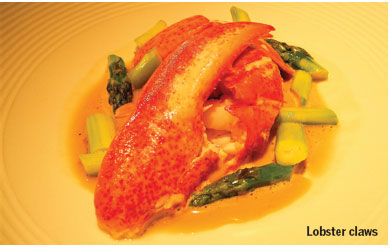Basic lobster for rolls, salads, an elaborate thermidor, baked or BBQ-ed
Updated: 2013-07-05 07:20
By Maggie Beale(HK Edition)
|
|||||||

With Hong Kong's handsome skyline showing at its best against summer's blue skies on most days now, it's time to treat yourself to a first class dish of perfectly cooked lobster. The king of the crustaceans, lobster is a delicacy that commands a high price, with white, firm meat that is sweet and succulent. Before it is cooked, lobster shell has a very dark colour, with tints that range from blue/green to red/purple - it only turns to its distinctive deep red brick colour when it's cooked.
Seen as one of the top most desired dishes in fine dining, lobster needs to be cooked to perfection -otherwise flavors and textures will be lost - not always easy for home-cooks. And the cooking times are crucial. To get firm advice on how to pick the best, I turned to a culinary master, Mark Bannon of the Langham Hotel. As the Exec Chef F&B there, Mark also oversees the Bostonian restaurant where the summer specialities will be Boston lobster dishes - some served with foie gras - so where better to ask for advice on how to pick a good one!
"To get a good, live lobster, pick one that is lively and has shiny eyes, It should smell very fresh. Make sure the claws are firmly banded - they can give you a painful nip. Straighten out its tail when you pick it up and it should swiftly curve it back under its body."
To cook a live one, fill a large pot with enough water to cover the lobster/s by an inch or two but don't put it in just yet. Bring the water to a strong boil. Do not add salt as it will cause the water to boil all over your cooker!
When the water re-boils plunge the live lobster in head first and slam on the lid. Hot steam passing through the shells will cause a whistling noise that's been likened to screaming - it's not. As the water starts to boil again, start your timer.
A 1lb lobster should take 3-4 minutes to blanch, certainly no more than 5 minutes. Don't overcook. Wear gloves, and grasp each lobster firmly with a pair of tongs as you remove it from the water - but keep the water until you are sure the lobsters are cooked. Cool them carefully - they will be very hot. Break the tail away from the body and keep or rinse out the tomalley - the greenish substance (if you don't want it) - its the liver and considered by many to be a prime delicacy.
Snip along the sides of the softer tail shell with strong kitchen scissors and take the meat out. Remove the bands and using a shell cracker or very clean pliers crack the claws, and ease the meat out. The tail meat should appear firm and white. If there is any sign of translucent greyish colour, it is not cooked yet. Throw the tail back into the boiling water and test at one-minute intervals until done. Do remove the digestive tract (the dark line that runs along the length of the tail).
Eat cold or hot with melted butter or a squirt of lemon juice Or, to finish off with flair, you can cook the (in-shell halved longways) lobster tails on the BBQ or grill with a little seasoned butter. Remove the flippers from the tail. If you're in luck and have a female, you may find red-coloured roe in this tail section, it is lobster caviar, a tasty and highly prized delicacy also.
Crack the legs but leave them intact so you can suck the meat out - that's part of the fun! It's why a finger bowl of water is a must at the table.
At the Bostonian restaurant the chef roasts the smashed lobster shells with sliced carrots and onions before adding 1 glass of white wine and stock and cooking for 30 minutes, then he drains the stock into a clean pan and adds 2 Tbsp fresh double cream before emulsifying the foie gras.
Lobsters should be live, but even *frozen lobsters can be delicious. * First, thaw frozen lobster tails by placing them directly into cold water for 30 minutes. For larger-sized tails (bigger than 10 oz each), change the water after the first 30 minutes and thaw for 20 minutes more. They are thawed when they feel flexible. Next, fill a pot with enough water to cover and bring the water to a boil before adding the tails to the pot. Allow the water to reach a slow boil before reducing the heat and simmer uncovered for 3-4 minutes before testing for doneness. If the flesh is still translucent or the roe is black and shiny then cook some more. The flesh should be fairly firm and completely white and the cooked caviar roe bright red.
Enjoy with a fresh chardonnay, viognier or sauvignon blanc wine, chilled lime soda, Japanese green tea - sencha or bancha, or, best of all - green oolong.
(HK Edition 07/05/2013 page7)